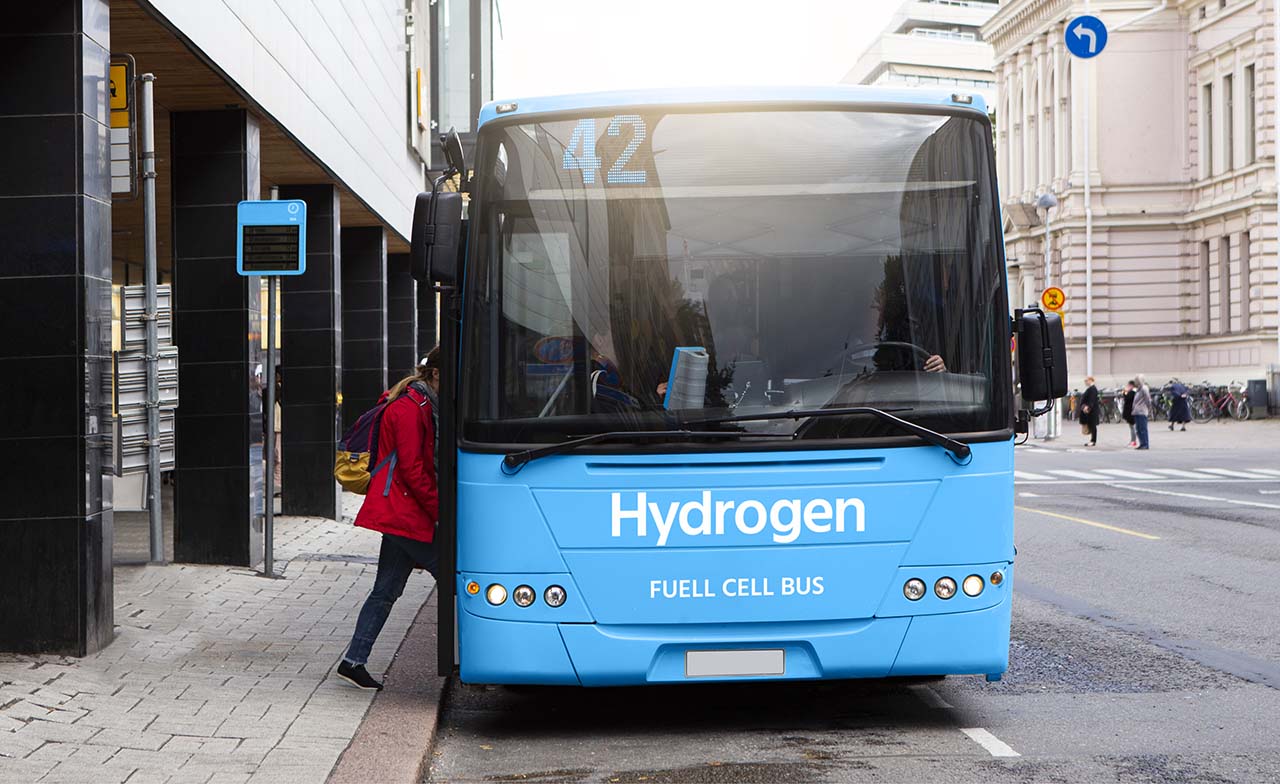As the global race to net-zero emissions continues and demand for clean energy sources intensifies, the hydrogen industry is poised to boom and unlock unprecedented opportunities for a healthy planet.
As the one of only fuels with the potential to decarbonize economies, hydrogen has captured the attention of governments, industry leaders and environmentalists worldwide.
Clean hydrogen is fueling an emerging hydrogen economy and its potential to drive innovation, transform energy generation and make green energy available on an industrial scale, ushering in a new era of hydrogen-based energy efficiency.
Green hydrogen, produced through electrolysis powered by renewable energy sources such as wind or solar, can help to decarbonize a range of sectors that have struggled to reduce harmful emissions, including steel manufacturing and long-haul transportation. Due to its versatility, hydrogen also has the potential to reduce emissions in the shipping, rail and aviation sectors, as well as in residential power and heating.
Industry currently makes up the bulk of hydrogen demand for use in oil refining and in the chemicals and steel sectors, where it is produced as gray hydrogen using fossil fuels such as coal and natural gas and thus responsible for significant annual CO2 emissions.
Green hydrogen uses electricity from renewable energies to split water into hydrogen and oxygen via electrolysis. No CO2 is produced, making it the cleanest form of hydrogen fuel. Blue hydrogen is produced with natural gas using the steam methane reforming (SMR) method and the resulting CO2 emissions are captured and stored.
Green hydrogen delivers a new dimension of energy efficiency
Hydrogen is not a direct source of energy but rather an energy carrier. It serves primarily as a means of storing energy for future use. The seasonal and unpredictable nature of solar and wind energy has heightened the focus on energy storage while also bringing market flexibility and energy distribution into sharp focus.
That’s where hydrogen is poised to play a pivotal role. The first wave of the transition to a green hydrogen economy will be industry-driven and the next wave will be mobility-related, thanks to hydrogen’s potential as an alternative for heavy industry and long-haul transportation uses, as well as for aviation, shipping and rail transportation.
As an alternative to diesel fuel, for example, clean hydrogen has the potential to decarbonize the heavy-duty trucking sector – which globally is responsible for about one quarter of global road emissions despite representing just 1% of total fleet vehicles.
While hydrogen itself is a clean-burning molecule that can be used in fuel cells to generate emission-free electricity, producing hydrogen is a complex process that requires precise control of various parameters to ensure efficiency and safety. Advanced technologies are needed and emerging to improve our understanding and control of these processes.
Back to top
Global leaders shaping the hydrogen journey
1. Europe
Europe, through a strategic mix of funding, innovation and ecosystem collaboration, is making significant strides in exploring hydrogen's potential to meet ambitious net-zero emissions targets.
Hydrogen valleys now operating across Europe are showcasing hydrogen’s distinct and unprecedented advantages. Projects that simulate a modern hydrogen ecosystem – from production and storage to transportation and consumption – are providing crucial opportunities to learn about future technology needs and how the value chain should work.
Meanwhile, the European Hydrogen Backbone (EHB) initiative is focused on establishing dedicated hydrogen-transportation infrastructure across Europe. More than 30 transport service operators in Europe are working on how best to transport hydrogen from diverse suppliers to various industries that have the biggest need for hydrogen.
From a regulatory perspective, Europe is strategically focusing on 20 hydrogen action points. Respectively, the action points focus on Europe’s hydrogen investment agenda, its enabling and supportive framework, boosting supply and demand, and the international dimension. Some key considerations and examples are outlined below.
Production
On the hydrogen production side, some caution can be observed. On one hand, many different hydrogen production locations and constructions are discussed. Besides onshore electrolyzers, the focus lies on offshore electrolysis. For example, the French developer Lhyfe has announced the results of its pilot floating offshore hydrogen platform, which was tested for six months, 20km off the coast in northwestern France. On the other hand, multiple examples can be given of companies postponing their electrolyzer FID’s and lowering the related initiated hydrogen production targets.
Transportation
One of the intended means of hydrogen transportation is pipeline. Focusing on the Netherlands, the first section of its hydrogen network, a stretch of over 30 kilometres, is being built in Rotterdam. The national network will ultimately span 1,200 kilometers and consist largely of repurposed existing natural gas pipelines. The network will be linked to large-scale hydrogen production facilities, import terminals, and companies in the Netherlands and abroad that will be switching to hydrogen.
Storage
When relying on renewable energy sources, besides infrastructure also flexibility is needed within the related renewable hydrogen market. An example of a potential system flexibility provider includes hydrogen storage. Currently, salt caverns are being initiated, to store hydrogen underground. Besides these caverns, the focus lies on hydrogen storage in gas fields. For example, at the Bierwang underground gas storage site in Germany. Within this gas field, the company Uniper is injecting natural gas/hydrogen gas mixtures, to be able to determine the related processes in the subsurface.
Consumption
The consumption developments differ significantly between countries. For example in Germany, the demand for green hydrogen recently increased significantly, partially due to the country its updated National Hydrogen Strategy, in which the targets for hydrogen production capacities have been raised. Focusing on hydrogen consumption by mobility, hydrogen refueling stations are being developed steadily. The specific status of the European refueling infrastructure can be tracked on several interactive maps. Specifically, these maps show publicly accessible and operational hydrogen refuelling stations (HRS), presented by location and dispenser type. An example includes the HRS Availability Map.
2. Canada
While Europe is leading the way, Canada is also moving forward as a leader in hydrogen production, sitting among the top ten hydrogen producers globally and housing the world’s largest clean hydrogen facility.
The government of Canada’s commitment to creating a clean hydrogen economy includes a target to supply up to 30 per cent of the nation’s energy in the form of hydrogen and to become one of the top three clean hydrogen producers globally by 2050.
Some Canadian regions are taking advantage of existing infrastructure to advance clean hydrogen initiatives. Alberta is repurposing existing pipeline infrastructure to distribute hydrogen at volume versus transporting it via trucks or trains. In a first-of-its-kind project for Alberta, natural gas producer ATCO is delivering a blend of natural gas containing hydrogen into a section of the Fort Saskatchewan natural gas distribution system, with hydrogen-blended natural gas being used reliably to fuel homes and businesses. Such hydrogen blending is becoming popular in advanced economies around the world.
Edmonton International Airport is one of the first airports in Canada to actively pursue and invest in the transition to hydrogen as an alternative fuel source – not only for aircraft but all related transportation, including trucks and carriers that are part of the air-transport ecosystem.
Meanwhile, future opportunities to develop hydrogen production in Alberta’s indigenous communities are also being explored.
3. The U.S.
In the U.S., the Department of Energy prepared the U.S. National Clean Hydrogen Strategy and Roadmap. Working with other US Federal agencies and stakeholders, the document outlines key actions for enabling successful market adoption of clean hydrogen technologies in support of a net-zero green house gas (GHG) emission economy by 2050, including key initiatives and milestones through 2025, 2029 and 2035.
Three key strategies underpin the roadmap, which focuses on the development and widespread implementation of clean hydrogen as a highly effective environmental tool to reduce carbon emissions and maximize and economic benefits:
- Identify and prioritize strategic use cases for clean hydrogen that can have the greatest impact in reducing emissions.
- Implement policies and incentives that prioritize the deployment of cost-competitive clean hydrogen solutions over traditional fossil-based alternatives.
- Prioritize regional hubs – Hydrogen Hubs – that facilitate large-scale clean hydrogen production in close proximity to key hydrogen users, enabling the sharing of critical infrastructure and resources.
In late 2023, US OE announced the creation of seven regional hydrogen hubs around the country with a collective funding of about USD $7 billion.
The table below provides the breakup of the funding and the corporate partners who are involved in the project.
| Hydrogen hub |
Funding |
Appalachian Regional Clean Hydrogen Hub
(ARCH2) |
$925 million |
California Hydrogen Hub
(ARCHES) |
$1.2 billion |
Gulf Coast Hydrogen Hub
(HyVelocity) |
$1.2 billion |
Heartland Hydrogen Hub
(HH2H) |
$925 million |
Mid-Atlantic Clean Hydrogen Hub
(MACH2) |
$750 million |
Midwest Alliance for Clean Hydrogen
(MachH2) |
$1 billion |
Pacific Northwest Hydrogen Hub
(PNW H2) |
$1 billion |
Back to top
CGI is making a difference globally
As the hydrogen trend continues to gain momentum, CGI is playing an important leadership role. CGI is committed to accelerating the transition to a hydrogen economy based on our deep and proven energy sector expertise that includes energy market liberalization, renewables management, data management and license to operate.
Our specialists are working with major energy and utilities organizations to advance the unique role they can play in accelerating the decarbonization of our planet, including initiatives to:
- Support green hydrogen trading targets set by governments;
- Identify end-users early in a project’s lifecycle, ideally during feasibility;
- Consider the production of green hydrogen close to demand sites;
- Combine green hydrogen production and storage with wind and solar power plants;
- Develop a global hydrogen market to advance supplier diversity and energy security.
Our success with organizations charting a new path to hydrogen production and use includes an client initiative for end-to-end control of one of Europe’s largest green hydrogen plants. Iberdrola chose CGI to implement a pivotal new solution that accurately monitors its entire hydrogen-production process. Operators now have the tools, indicators and alarms needed to manage the complete manufacturing journey, integrating systems that control the photovoltaic plant’s energy production with the production and supply of hydrogen to the facility.
A major European gas-transmission operator turned to CGI as it set out to integrate hydrogen into its current value chain. Establishing a commercial data-exchange platform was too complex to manage by spreadsheet and too costly to integrate directly into the company’s legacy IT landscape. With our intelligent data exchange platform CGI AgileDX-Hydrogen, we jointly developed a proof of concept and the power to scale in just five weeks.
CGI experts are currently working as well with future-focused steel makers in Sweden as they pursue new hydrogen initiatives and capabilities that aim to optimize clean steel production. Leading global auto manufacturers developing significant new hydrogen strategies are also collaborating with CGI to unlock new opportunities.
Back to top











